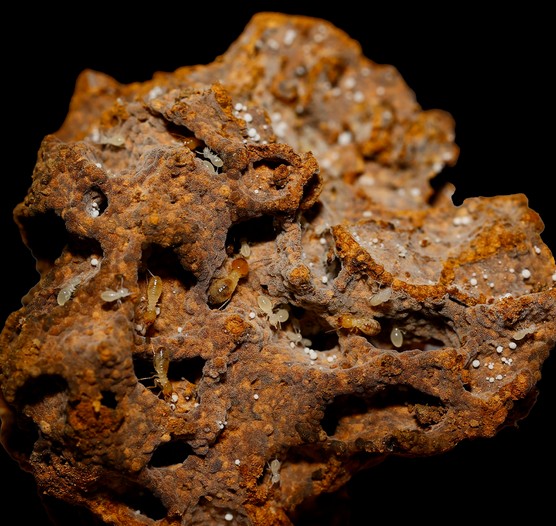Research Summary: Termites remove, clean and encase the weed with soil boluses containing bacteria that can prevent the fungi. So, it seems, termites have their own version of integrated pest management.
Author interview

Dr. Aanchal Panchal recently completed her PhD at IISER Mohali, where she worked with fungus-farming termites in the lab of Dr. Rhitoban Raychoudhury.
LinkedIn | Twitter | Instagram
Lab: Dr. Rhitoban Raychoudhury, Indian Institute of Science Education and Research, Mohali
What was the core problem you aimed to solve with this research?
The core problem we aimed to solve was understanding how fungus-farming termites keep their fungal gardens free from the invasive “weed” fungus. While it was known that microbes exist in these systems, it was unclear whether termites actively use them to control weeds and if they do, what mechanisms allow them to suppress the weeds without harming their crop fungus. So, therefore, we wanted to investigate how termites use fungistatic remedies only against the weed while keeping their own fungal crop unaffected.

How did you go about solving this problem?
To explore this, we designed a series of behavioral experiments where termites were given a choice between a fresh fungal comb and combs infected with different intensities of the weed fungus Pseudoxylaria. We observed that when Pseudoxylaria hyphae was given on a fresh comb, termites physically removed and buried them elsewhere using soil boluses. In contrast, when the infection was severe, the entire comb was covered with soil boluses. However, the fresh comb is kept unaffected without any deposition on it. The presence of microbes was already known in termite systems, but it was unclear whether termites actively used them and if so, how. To test this, we examined the soil boluses and found that they indeed contained microbes capable of suppressing the fungal weed.
How would you explain your research outcomes (Key findings) to the non-scientific community?
Termites make specialized structures known as fungus combs to grow their food, a fungus called Termitomyces. But just like in human agriculture, these fields are also invaded by weeds. When you remove termites, Pseudoxylaria, the weed takes over the comb very quickly. So how do termites prevent this weed? We conducted a simple experiment where we gave termites a choice between a fresh comb and a comb infected by Pseudoxylaria and found that termites could remove the weed away from the comb and bury it with soil boluses. However, when the infection was very extensive, they did not bother retrieving the comb and simply buried the entire infected comb with soil boluses while they kept the fresh comb unaffected and did not deposit any soil bolus on it. When we glued a fresh and an infected comb together, termites proceeded to separate the fresh comb piece out of the infected comb and saved the fresh comb which could be used to regrow their crop. They buried only the infected parts of the comb with soil boluses. So, what is so unique about these soil boluses? To find out the nature of these soil boluses, we made extracts of it and found they can prevent fungi. Next, we wanted to know what bacteria are present in these soil boluses and we found bacteria that can prevent fungi. So how do termites deal with the fungal weeds in their fungal gardens? Termites remove, clean and encase the weed with soil, which has bacteria that can prevent the fungi. So, it seems that just like humans, termites also have their own version of integrated pest management.
What are the potential implications of your findings for the field and society?
Our study shows how fungus-farming termites use their behavior and microbes to protect their food source from harmful “weed” fungi. Termites carefully isolate and cover the invading fungus with soil containing natural microbes that stop its growth without harming their crop fungus. These findings help us understand how termites have evolved their own form of sustainable farming to keep their gardens healthy. Learning from such natural systems can inspire new, eco-friendly ways to manage pests and diseases in agriculture and reduce our reliance on chemical treatments. Additionally, the microbes associated with termites and their natural products may have medicinal uses in developing new antimicrobial treatments and other therapeutic options.
I was lucky to have such a capable person as Aanchal. — Dr. Rhitoban Raychoudhury
What was the exciting moment during your research?
One of the most exciting moments in our research was when I tried to mimic the termites by covering the infected comb with sterilized soil and it did not stop the weed from growing. Later, when we discovered that termite deposited soil boluses contained special microbes that stopped the weed, this was the moment, we knew, we had a great story to tell.
Paper reference: Panchal A, Sen R, Agarwal R, Rana A, Raychoudhury R. Fungus-farming termites can protect their crop by confining weeds with fungistatic soil boluses. Science. 2025 Sep 25;389(6767):1366-71. DOI: 10.1126/science.adr2713
Explore more
🎤 Career – Real career stories and job profiles of life science professionals. Discover current opportunities for students and researchers.
💼 Jobs – The latest job openings and internship alerts across academia and industry.
📢 Advertise with BioPatrika – Reach the Right Audience, Fast!
🛠️ Services – Regulatory support, patent filing assistance, and career consulting services.




